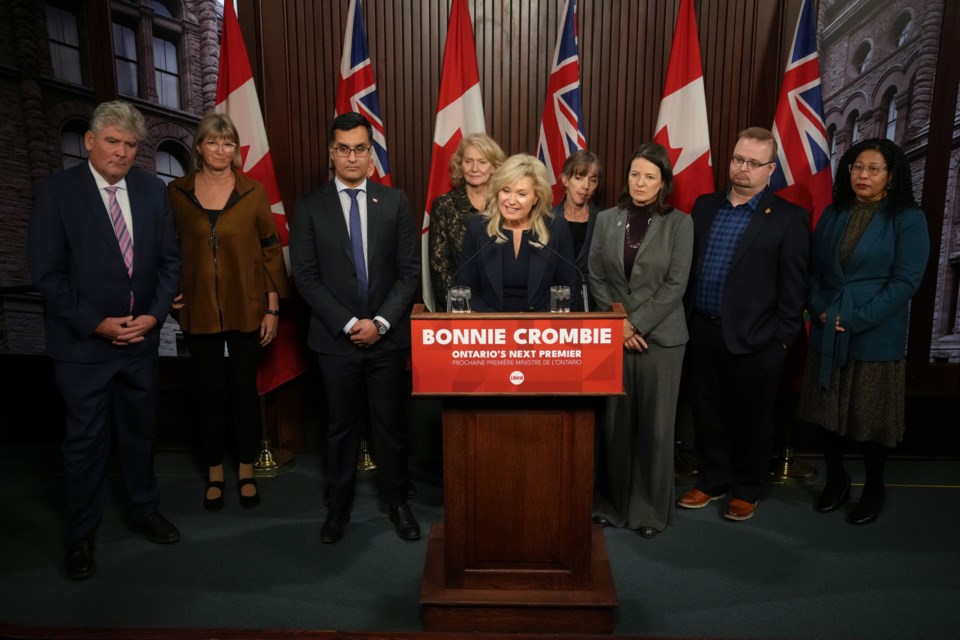EDITOR’S NOTE: This article originally appeared on The Trillium, a Village Media website devoted to covering provincial politics at Queen’s Park.
The Ontario Liberals unveiled new housing legislation on Tuesday to legalize gentle density around the province in an attempt to establish their position on the issue ahead of the Progressive Conservatives' next major housing bill.
Newly minted Liberal housing critic Adil Shamji’s bill, the BUILD Ontario Act, would legalize four-unit, four-storey buildings across Ontario and introduce new province-wide standards to prevent municipalities from creatively thwarting multiplexes.
“If passed, this legislation will accelerate the development of housing across our province by implementing some of the major recommendations from the government's own housing affordability task force report,” Shamji said.
Liberal Leader Bonnie Crombie joined Shamji at Queen’s Park to unveil the bill and took aim at the Tories for “dither(ing)” on housing.
“The Ford Conservatives have refused to take action to get homes built faster, so we're stepping up to get it done,” Crombie said. “Ontario Liberals have a plan to deliver on what Ontario families need so that the next generation has the same shot at success as their parents and their grandparents did.”
Crombie’s critique comes as the PCs make slow progress toward their housing targets. Ontario saw just over 109,000 housing starts in 2023 as interest rates continue to affect construction pace. That number also includes 18,000 long-term care beds and additional residential units like basement suites added to existing homes. Just over 89,000 were traditional housing starts, which is down from past years.
Ontario needs at least 150,000 starts per year to meet the 1.5 million homes by 2031 promise.
The bill has almost no chance of passing through the PC-controlled legislature because it was introduced by the opposition Liberals. Green Leader Mike Schreiner recently introduced a similar bill, which the Liberals supported, only to see it sent to die in committee.
Some of the measures could, however, be seen in the PCs’ next housing bill. A government source told The Trillium cabinet has debated the multiplex issue. Housing and Municipal Affairs Minister Paul Calandra recently told reporters the bill will come shortly after the March 26 budget.
Legalizing multi-unit dwellings is the single biggest step the province could take to tackle the housing crisis, according to the housing affordability task force report.
Even if the government took that step, municipalities could still introduce measures rendering fourplexes legal on paper but incredibly difficult to build in reality.
Shamji’s bill proposes province-wide standards to make fourplexes legal and easy to build, though experts said it could still be strengthened, which Shamji said he’s open to should the bill ever stand a chance of passing.
“This bill deals with a lot of poison pills that kill a lot of development that we otherwise want to permit,” said Alex Beheshti, a senior consultant with the Altus Group, a construction and real estate consulting firm.
One common way municipalities try to limit fourplexes is by requiring they be built on lots of a certain size. Shamji’s bill would remove the minimum lot size requirement so they can go up anywhere.
The bill doesn’t say anything about frontage rules, which refer to the amount of land between a building and the road.
Sean Galbraith, an urban planner specializing in developing multiplexes, said this is a common stumbling block for multiplexes. Lower and less strict frontage requirements would give more space for the actual house, making it easier and more economical to build, he said.
Shamji’s bill would also prevent municipalities from imposing bylaws capping building heights at anything less than four storeys, though Galbraith pointed to some potential loopholes.
“What it doesn’t say is a limit in the number of metres,” Galbraith said. “So there’s a question of, can you have no limit in the number of storeys but an eight-metre height limit? I don’t see how you’re getting four storeys in eight metres.”
The bill also limits municipalities’ ability to introduce floor-to-area ratios, which are often used as a way to measure — and cap — density.
The floor-to-area ratio, also known as the floor space index, measures the amount of useable floor area in a building against the total lot size.
A one-storey building taking up the entire lot and a four-storey building taking up a quarter of the lot both have a floor-to-area ratio of 1. The higher the number, the more dense the building.
Finally, the bill would eliminate minimum parking requirements for fourplexes. Parking requirements drive up costs and reduce the amount of space a builder can use, which can doom a multiplex project, Galbraith said.
Removing those requirements for fourplexes would help a lot, but not extending them to triplexes “doesn’t really make sense,” Galbraith said.
Shamji said he “consulted widely” before writing the bill to be “thoughtful of the barrier that homebuilders and homeowners are facing.”
“That being said, if there were additional barriers that need to be addressed, we would welcome the opportunity to meet with stakeholders to understand what they are. And so long as they’re reasonable, help implement them into the legislation to make it as fair, equitable and relevant to introducing fourplexes in the province,” he added.
If a bill like this were to become law, it would have more of an impact on smaller suburban areas, Galbraith said, because some larger municipalities have already started implementing these measures thanks to the federal government’s housing accelerator fund, which essentially bribes municipalities to pursue zoning reform.
Federal Housing Minister Sean Fraser has struck $1.3 billion worth of deals with 19 mayors across the province in the past eight months.
“This doesn’t go as far as Toronto in a number of respects, but certainly is a lot better than what a lot of the suburban municipalities have done so far and this would be province-wide,” Galbraith said.
